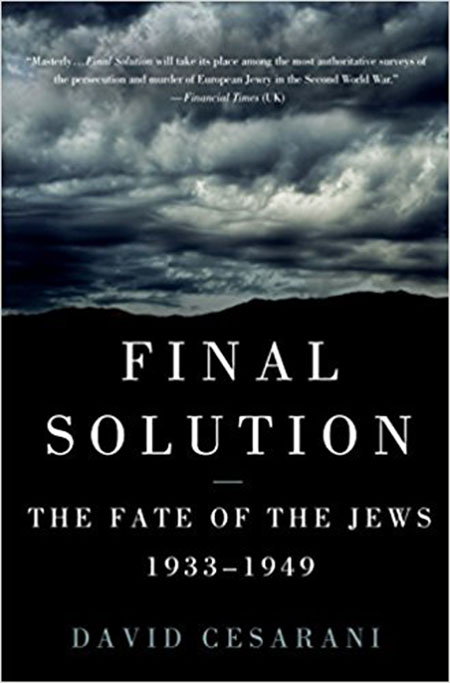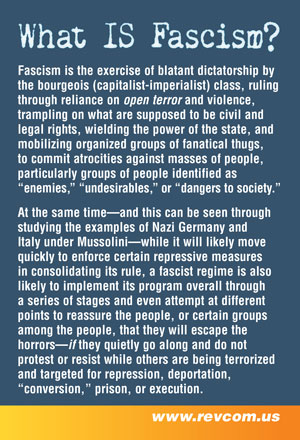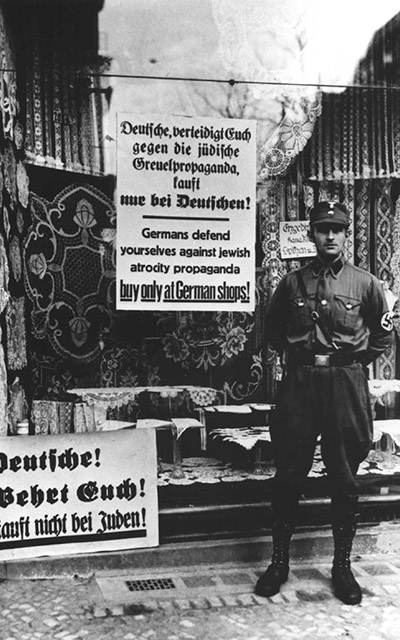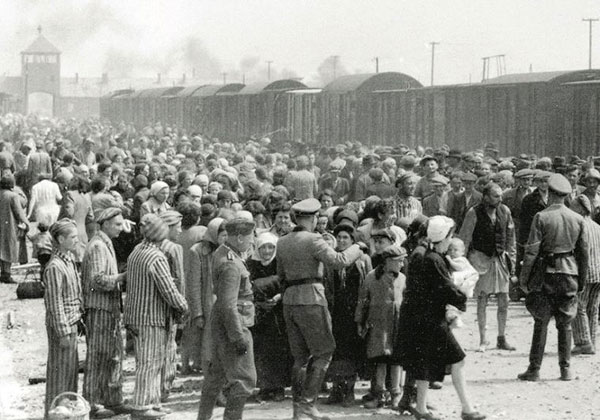Letter from a Reader:

Reflections on the Book by David Cesarani: Final Solution:
The Fate of the Jews 1933-1949
Twists and Turns, and Deadly Illusions... On the Road to the Death Camps
February 12, 2018 | Revolution Newspaper | revcom.us
I recently read David Cesarani’s 2016 book, Final Solution: The Fate of Jews 1933-1949, particularly focusing on chapter 2, “Judenpolitik 1934-1938.” Some readers of Revolution might be aware that the Holocaust—the genocidal mass murder of six million Jews along with communists, Roma people, gay people, others—didn’t just come out of nowhere. But what a lot of people don’t know is that the period leading up to and setting the stage for the Holocaust was marked by zigs and zags, twists and turns. Cesarini shows how those twists and turns over and over led people who were outraged by Hitler to misread that pattern as proof that the worst was behind them. In reading this, I could not help but think about the current situation we face in this country.
To Hitler and the Nazi core, the Jews within Germany and “international Jewry” were, along with the communists, the existential enemy. To them World War 1 wasn’t lost on the battlefield, but because of betrayal by the enemies within. Expelling the Jews from Germany became a centerpiece of the Nazi program.
While this was their goal, on coming to power they had not developed a concrete plan for how to achieve it. “Anti-Jewish policy in the first years of the Nazi regime was marked by improvisation and muddle,” Cesarani writes. Hitler’s overarching concern was restoring Germany to its rightful place—Deutschland Über Alles—(Germany Above All Else). Germany faced enormous problems; number one was an economy that had been devastated by the worldwide depression, made worse by the punishing reparations as a result of its defeat in the war. This intersected with the Jewish policy and the moves Hitler made to implement it.
Driving the Jews from Germany, and Its Contradictions
The overall approach the Nazis took was to make the conditions for Jews within Germany so intolerable they would realize they had no choice but to leave the country. Just one month after the Nazis took power, the first major laws were passed to take rights away from “non-Aryans”—principally Jewish citizens. Jews were banned from holding civil service jobs, and from admission to the bar. This was the first use of what came to be known as the “Aryan paragraph.” As it was applied across civil society, “non-Aryans” (Jews) were expelled from sports clubs, recreational associations, professional networks, and cultural organizations.
But the Nazi strategy for the Jews came into conflict with other parts of their program. While the new government was removing Jews from political and cultural life, Jews were still permitted to own and operate businesses, because they were essential to Germany’s economic recovery. In this period Jews in the cities were benefiting from the economic revival. This both incensed the Nazi rank-and-file and persuaded some Jews who had emigrated right after the Nazis took power that things had stabilized, and would not get worse—and so many returned.

Cesarani quotes a New York Times correspondent who saw the situation much more soberly: “Whatever lull follows will be only temporary. Moreover, each new attack begins from where the last one left off.”
“Educating” Germans of the Evil of Jews
The level of anti-Semitism varied significantly in different parts of the country. In the countryside almost every village had a sign—“Jews not wanted here.” At the same time, the Catholics in these areas generally opposed these attacks on the Jews. In major cities like Berlin, where nearly a third of all Jews lived, while violence and boycotts of Jewish shops did not disappear, Jewish businesses and Jewish life went on. This was becoming intolerable to the most rabid anti-Semitic sections of the Nazi party.
Enter the Gestapo—the Nazi secret police. With their encouragement, violence against Jews escalated. A campaign was launched in late 1934 to “educate” Germans about the evil of the Jews. Lurid tales appeared in Der Sturmer, a Nazi propaganda paper, of the defilement of “Aryan maidens” by Jewish men. Waves of anti-Semitic violence were whipped up; Jewish shops were attacked, and Jews were brutalized in the streets, while police and onlookers did nothing.
With the violence by the party rank-and-file mushrooming, Nazi leaders met, convinced for pragmatic reasons that something had to be done. Some were concerned that it was threatening the economic basis for rearmament. Others blamed the Jews, and insisted that the “anti-Semitic mood” of the people demanded that Jews had to be eliminated from the economy immediately.
The Nuremberg Laws
Hitler intervened, searching for a course that would give the Nazi faithful something “spectacular,” but that didn’t provoke an international boycott of the approaching Olympic Games, scheduled to be held in Germany. In September 1935, the Nuremberg Laws were passed: intermarriage was outlawed, and Jews were stripped of German citizenship. Hitler then warned that random acts of revenge by “party zealots” were no longer acceptable. Many Jews and their sympathizers were actually relieved, feeling that at least the new laws held out the promise of stability and an end to random abuse. Jews had now lost their political rights and even more social rights, but the economic rights of those still in business were not affected.
W.E.B. Du Bois, one of the foremost Black intellectuals of the early 20th century and fighter for decades against the oppression of Black people in the U.S., captured the painful new world of Jews in Germany. On his return from a visit to Germany around this time, he wrote that the Nazis’ “campaign of racial prejudice” against Jews “surpasses in vindictive cruelty and public insult anything I have ever seen; and I have seen much.”
Du Bois, with a breadth of historical knowledge and personal experience, could see more clearly than those directly embroiled in the situation.
The 1936 Berlin Olympics... and War Preparations
For Hitler, 1936 was the year of the Olympics, with both the winter and summer games to be held in Germany. This was a unique opportunity to project his powerful and self-confident “Aryan nation” on the world stage. But the anti-Semitism would have to be somewhat toned down to do so. Anti-Semitic signs and banners were removed from areas where international visitors would go, and Der Sturmer was removed from newsstands during the Games.
Judging from the aims of the regime, the Olympics were a smashing success. But the illusion created in this period that Jewish life could be maintained in this “new normal” quickly came to an end.
Only weeks after the1936 Berlin Summer Games, Hitler circulated a secret memorandum among top Nazi leaders arguing that Germany had to prepare for war within four years. This would have profound implications for the Jews in Germany. Hitler had always seen “international Jewry” and the Soviet Union as profoundly linked. The Soviet Union would be Germany’s principal foe in that war, and in the Nazi view this war could not be fought without intensifying the forced removal of the Jews from Germany and the increased suppression of those who remained.
Those within the regime holding out for some role for Jews in the economy were removed. Major measures were taken by the Nazi government forcing Jewish businesses to close, or to transfer ownership to Aryans at a fraction of their worth. Doctors, lawyers and other professionals were no longer allowed to practice their professions. Restaurants and other public facilities refused to serve Jews. The basis for Jewish economic and social life was being destroyed, with the message—Jews out of Germany.
Over the next two years, Jewish sentiment toward emigration fundamentally turned toward leaving. But by this time many could not afford the cost of emigrating, while more and more countries were closing their doors to Jews. (In a disgraceful 1939 incident, the U.S. turned away 900 Jewish passengers fleeing Nazi Germany aboard the St. Louis, seeking refuge in Cuba and then Miami. The ship was forced to return to Europe, and more than 250 of its passengers died at German hands.)
On November 9-10, 1938, would come Kristallnacht—the “Night of Broken Glass”—when Nazi paramilitary mobs torched synagogues, vandalized Jewish homes, schools, and businesses throughout Germany, Austria, and other areas occupied by German troops. Jewish women were raped; over 100 Jews were murdered; and 30,000 Jewish men were arrested and sent to Nazi concentration camps. Kristallnacht marked a turning point in the scale, the organized character, and the horror of what was done.
Now the virulent anti-Semitism and the complete demonization and exclusion of Jews had become utterly normalized. Cesarani refers to a professor who described how the Nazi appeal to their racially unified community “had become common sense, bringing with it the exclusion of certain groups without the need for conscious hatred.”
Through repeated zigs and zags, the Nazis carried out their program for eliminating the Jews from Germany, and from the countries it conquered. Hitler and the Nazis improvised as they consolidated fascism, and the best of people convinced themselves that each change in the situation could be an indication that “it can’t happen here after all,” that “the worst is past,” that “the international community won’t allow this,” or that “more rational voices in the regime will prevail.” Yet none did. Two and a half years later, with the war now begun and millions of Jewish people under direct German military rule, the Nazi leadership came up with the plan for the “final solution to the Jewish question”: the complete eradication of the Jewish people.
Volunteers Needed... for revcom.us and Revolution
If you like this article, subscribe, donate to and sustain Revolution newspaper.



